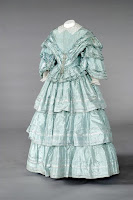Fortunately, Puresilks recently had some silk at $6 a yard so I snapped up 2 dress lengths. The people at PureSilks were awesome! Neither of the colors that were $6 were in stock, so they let me pick any custom color I wanted. I ordered one in an emerald green shot with electric blue. Ther other one was a sky blue tissue taffeta. Even though it was blue, I immediately thought of these dresses:
Even though they were pink, I felt the blue fabric wanted to be made into something like this. Plus, they have my absolute 2 favorite things in dresses: flounces and scallops. Perfect!
I wanted to have them done before Landmark Inn on March 18th. I got the fabric March 14th and spent the better part of 2 days figuring out the math to make the flounces. I still don't have it right. When I gauged the skirt, it pulled up the top layer and made it shorter, thus making it look like the second flounce was much too long. All I need to do is put the second flounce 2 inches higher. It shouldn't take too long, but I went ahead and wore the skirt anyway.
With the skirt, I made a sheer voile basque with it. The weather was going to be over 80 degrees Fahrenheit so I didn't want to wear my velvet basque. The effect turned out quite lovely and it was very cool. I wore with the ensemble a straw hat trimmed with green and blue ribbon, covered in the veil (I got neither the new bonnet or the parasol completed in time).
The flounces themselves have little scallops within the larger scallops. I accomplished this is a scallop rotary blade. Here are some pictures of the progress and some close ups of the flounces.
I didn't use anything to keep them from fraying so they are fraying a little. Not a lot, though. I used some fray check for the very bottom tier because I knew it would get a lot of wear. It discolored the silk a little so I decided to only do that for that flounce.
I didn't use anything to keep them from fraying so they are fraying a little. Not a lot, though. I used some fray check for the very bottom tier because I knew it would get a lot of wear. It discolored the silk a little so I decided to only do that for that flounce.
I like the seated pictures best because they don't show the unevenness of the tiers. That will need to be fixed before I wear it again. I am very pleased with the overall effect, though, and look forward to my next project.
























